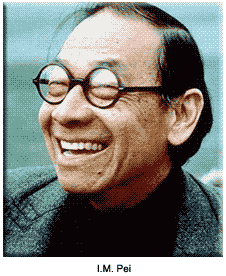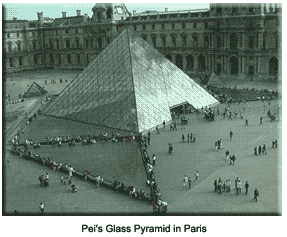Ieoh Ming Pei has given the 20th century, and beyond, some of the world's most beautiful interior spaces and exterior forms, including the spectacular Rock 'n Roll Hall of Fame cantilevered over Lake Erie in Cleveland, Ohio. Yet the significance of his work goes far beyond that. His concern has always been the surroundings in which his buildings rise.
 Pei has refused to limit himself to a narrow range of architectural problems. His work over the past 40 years includes not only palaces of industry, government, and culture, but also moderate- and low-income housing. His versatility and skill in the use of materials “approach the level of poetry.”
Pei has refused to limit himself to a narrow range of architectural problems. His work over the past 40 years includes not only palaces of industry, government, and culture, but also moderate- and low-income housing. His versatility and skill in the use of materials “approach the level of poetry.”
Pei's tact and patience have pulled together people of disparate disciplines to create a harmonious environment for each project's successful completion, no matter how daunting.
The early years
Pei was born in China in 1917, and came to the United States in 1935, to study architecture at the Massachusetts Institute of Technology. He received a bachelor of architecture degree in 1940, and was awarded the MIT Traveling Fellowship. He went on to the Harvard Graduate School of Design to earn a master's degree in architecture in 1946. There he was awarded the Wheelwright Traveling Fellowship.
Pei's subsequent honors include:
In 1958, he formed the partnership of I.M. Pei & Associates, which then became I.M. Pei & Partners in 1966. The partnership received the 1968 Architectural Firm Award of the American Institute of Architects.
Other partnership awards include:
“given to an established artist who has created a distinguished body of work and is recognized as a leader in the development of his or her art form. It is conferred upon I.M. Pei & Partners in recognition of the firm's architectural innovation and excellence, having enriched the American landscape with some of its most graceful and aesthetically satisfying works of architectural art." (1981)
 The Résumé
The Résumé
Pei has designed more than 50 projects in this country and abroad, many of which have been award winners. His more prominent commissions have included:
In his acceptance speech for the 1983 award, Pei said in part,
“. . . I belong to that generation of American architects who built upon the pioneering perceptions of the modern movement, with an unwavering conviction in its significant achievements in the fields of art, technology and design. . . . I believe in the continuity of this tradition for it is by no means a relic of the past but a living force that animates and informs the present. . . .“It is easy to say that the art of architecture is everything, but how difficult it is to introduce the conscious intervention of an artistic imagination without straying from the context of life. . . It is this fragility, this preciousness, that elevates and distinguishes this art form. It is this enfolding context that challenges us to transform planning and building opportunities into the exalted realm of architecture.”